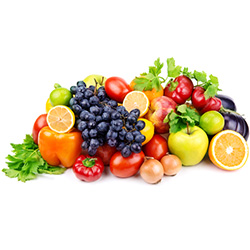Phytonutrients
 Carotenoids, bioflavonoids, flavonoids - what's the difference? Phytonutrients are a group of nutrients coming from plant pigments. They are divided into groups based on their chemical composition which is related to their color,
making them most easily identified by color groups.
Carotenoids, bioflavonoids, flavonoids - what's the difference? Phytonutrients are a group of nutrients coming from plant pigments. They are divided into groups based on their chemical composition which is related to their color,
making them most easily identified by color groups.
Carotenoids are the red, orange and red pigments found in fruits and vegetables. Green vegetables have lots of carotenoids, but the green color of chlorophyll hides the yellow color. More than 600 carotenoids have been classified. The ones we hear about the most are:
- Lycopene is the red color found in tomatoes, watermelon, red peppers and other red fruits and vegetables.
- Lutein is the yellow color (it means "yellow") found in marigolds, and yellow plants. It is a powerful antioxidant found in the retina and eye lens, and helps protect the eyes from UVA/UVB damage from sunlight.
- Astaxanthin is a powerful antioxidant critical for good vision that is found in muscles of pink seafood. Also helps support overall immune health and may have anti-cancer properties.
- Zeaxanthin is a powerful antioxidant found in the retina and eye lens, and helps protect the eyes from UVA/UVB damage from sunlight. It can be found in many green, red, and yellow vegetables and fruits.
- Meso-zeaxanthin is produced in the macula from lutein when there is not enough zeaxanthin present. This particular carotenoid is found in the center of the macula where we get our most detailed vision.
Bioflavonoids and flavonoids are different terms for the same thing. They are plant pigments which attract insects to plants for pollination, protect plants from UV radiation and behave like stimuli to different plant bio-chemical functioning.
- Quercetin acts synergistically with vitamin E and the amino acid taurine to support capillary integrity in the retina.
- Rutin is another antioxidant flavonoid that supports the integrity of blood vessels.
- Bilberry is well known for its support of vision health and its ability to absorb blue light thus protecting the retina from solar radiation.
- Catechins are the powerful antioxidant found in green tea.
- Epicatechins are a type of catechin, and are a more potent antioxidant than catechins in green tea.
Polyphenols, usually as tannins, are found in nearly all plant families as well as animal, insects, and sea-life. In plants they regulate hormones, protect against UV radiation, protect against animal/insect attack, and play a role in ripening. They are found in many herbal teas. Some types of carotenoids, such as lycopene, are polyphenols.
- Lignans a kind of polyphenol, found in fiber-rich foods such as rye cereal, flax seed, sesame seed, the cabbage family and some fruits. They are antioxidants that also reduce inflammation.
- Olive leaf contains polyphenols is an antioxidant and anti-inflammatory agent.
Indoles are aromatics used in perfumes and oils, and found in coal tar, and in plants, especially those of the cabbage family (kale, broccoli, brussel sprouts, etc). Researchers are investigating their potential role in cancer treatment.
Isoflavonoids are another type of bioflavonoid, some of which may be beneficial and some of which are identified as toxins.
- Isoflavones are one category of isoflavonoids, some of which are antioxidants. Rich sources include soybeans, peanuts, lentils, and other legumes. Diets rich in isoflavones may be tied to lower incidence of breast and other cancers, especially in Asian populations.
 info@naturaleyecare.com
info@naturaleyecare.com



 Home
Home



 Vision
Vision Vision
Vision



 Health
Health Health
Health Research/Services
Research/Services Pets
Pets About/Contact
About/Contact


